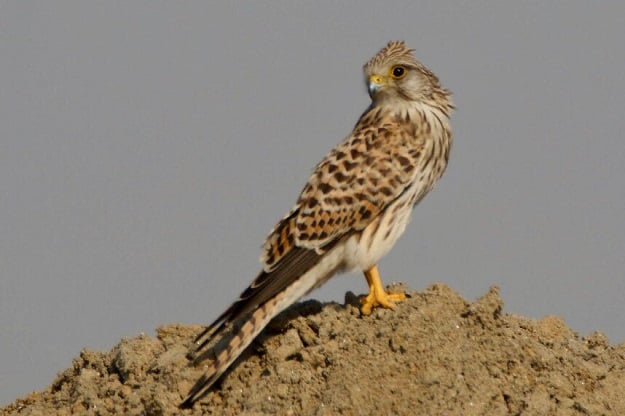Karachi is in danger of losing wildlife
Sparrows, parrots almost disappeared due to predatory birds, the disappearance of nesting places

Representational image. PHOTO: REUTERS
Although it is hard to believe, the metropolis - home to over 15 million people - boasted a rich wildlife up until a few decades ago.
Once a natural habitat for colorful birds, Chinkara deer, and predators like leopard, the city has lost its precious wildlife not only through the ravages of time, but also because of human influence, mainly unplanned urbanization, and indiscriminate killing.
Alteration of habitat, a direct result of unplanned urbanization and pollution, has badly hit the population of urban birds like house sparrow and parrots in the past two decades, according to the experts.
Instead of these human-friendly birds - which signify the quality of air - other bird species such as kites, crows, and mynas occupy the skies of today's Karachi.
Wildlife chief assures world-class Dera Ghazi Khan zoo
"For the younger generation, it is hard to believe that Karachi had had strong wildlife. But this is true. The city's western, eastern and northern outskirts had served as a habitat for several rare birds and animals, including leopards and dear until the 1960s," Muhammad Moazzam Khan, an advisor to World Wide Fund for Nature (WWF) Pakistan, told Anadolu Agency.
 Representation image. PHOTO: Anadolu Agency
Representation image. PHOTO: Anadolu AgencyThe last Chinkara deer, also known as gazelles and can be found in India, Pakistan, and Iran, were also spotted in the remits of Karachi in 1994, according to Khan.
The city's western outskirts had also served as one of the favorite hunting sites for professional hunters during the British colonial era. An undated picture shared by Khan showed a British hunter together with some locals with two dead leopards lying in front of him.
"Presence of leopards itself is proof that there was wildlife in Karachi to feed these predators," Khan said adding: "But it has gone almost extinct due to a perpetual influx of population, cutting of forests, massive constructions, and pollution-caused asphyxia".
He was referring to the unstoppable streaming of population into the city after the independence of Pakistan in 1947. The city's population in 1947 was just 450,000, which rapidly jumped to over one million in the following four years.
The colossal rise in population, Khan said, flanked by inadvertent urbanization, gradually destroyed the natural habitat, eventually leading to the extinction of several birds, reptiles, and animals like leopard, deer, hedgehog, snakes, and others in this part of the country.
 PHOTO: FILE
PHOTO: FILEThe situation in other big cities like Lahore, Faisalabad, Peshawar and Quetta is relatively better as they still have "marginal areas" to protect their wildlife to a certain extent.
"We cannot say this is satisfactory but relatively better compared to Karachi because they still have a village life as well," Khan said.
Where did parrots, sparrows disappear?
Experts see a rapid drop in nestling places by human influence, poor diet and rising air pollution as key reasons behind the disappearance of these birds.
According to the latest surveys, Khan said, the population of parrots and sparrows has dwindled 80% and 70 % respectively in Karachi for the past two decades.
State-owned zoos: Survival of the fittest
Cutting of trees and grasslands for wood, and construction purposes, on the one hand, has deprived these birds of their nestling places, and proper diet whereas, the increasing pollution and garbage sites, on the other, have led to increasing in population of "opportunistic" birds like kites, crows, and mynas.
Khan singled out kites, which are predators as well, as a major threat to sparrows and parrots.
"Growing pollution and garbage sites have increased the population many folds of opportunistic birds, which need food. And for that, these seed eaters, especially sparrows are their main target", Khan noted.
"Also, huge plantation of "outlandish" trees like conocarpus, mesquite, and eucalyptus, which otherwise have no disadvantage except for they do not provide nestling place to sparrow and parrots", he maintained.
Mesquite - small leguminous trees - have inflicted more damage on wildlife. Unlike eucalyptus, and conocarpus, it has spread out automatically causing damage to whatever left in the habitat of the city's suburbs.
Shabina Faraz, an analyst who frequently writes on the environment, shared a similar view.
 PHOTO: AFP
PHOTO: AFP"The lethal combination of dropping nestling places, the dearth of food, and predators like kites, have almost vanished sparrows in Karachi", she stressed.
Not only sparrows and parrots, she added, but kites had also forced several species of seabirds to move away from Karachi's beaches.
Bahawalpur to have a hunting village
Cutting of fruit gardens, which once sprawled on the eastern outskirts of Karachi, is cited as another reason behind the disappearance of parrots.
Effects on the environment
Experts reckon that a sharp rise in the population of wild pigeons in Karachi has also wreaked havoc on the environment.
The rapid growth in pigeons’ population is mainly because of numerous sites where citizens drop seeds and other birds feed as an act of mercy, attracting thousands of pigeons on each site every day.
These sites in the metropolis have been named as "Kabootar chowk" by citizens.
"This is not mercy but senselessness. By doing this, they are actually inviting trouble for themselves in the form of diseases and allergies," Faraz said, warning that "the trouble will be stupendous if any major disease breaks out due to pigeons".
She also said, the droppings of the pigeons added to the decaying of the infrastructure.
 PHOTO: FILE
PHOTO: FILEKhan, however, appeared to be unsure about the effects of damage to wildlife on urban ecology.
"No doubt, every animal or bird has a role in balancing the ecological system. But we still don’t know how it has affected the city’s environment," he said.
Faraz said that sparrows, parrots and other human-friendly birds would eat insects, flies, and mosquitoes, and their disappearance disturbed the balance in the environment but "major effects are still invisible, which would come into light in the near future".



















COMMENTS
Comments are moderated and generally will be posted if they are on-topic and not abusive.
For more information, please see our Comments FAQ